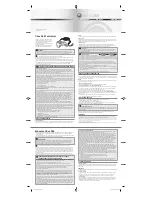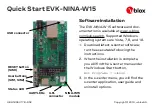
7.5.5 Protective (Safety) Stop
A Protective (Safety) Stop is designed for the connection of miscellaneous devices that could include safeguarding
(protective) devices and complementary equipment. This stop function is a type of interruption of operation that allows an
orderly cessation of motion for safeguarding purposes. The function can be reset or activated either automatically or
manually.
Protective (Safety) Stop Requirements
The required safety circuit integrity level is determined by a risk assessment and indicates the level of control performance
that is acceptable, for example, category 4, Control Reliability (see
Safety Circuit Integrity and ISO 13849-1 Safety Circuit
situation(s), and removing power from the machine actuators. This functional stop typically meets category 0 or 1 as
described by ANSI NFPA 79 and IEC60204-1.
7.5.6 Interlocked Guard or Gate
The Safety Controller safety inputs may be used to monitor electrically interlocked guards or gates.
Safety Interlock Switch Requirements
The following general requirements and considerations apply to the installation of interlocked guards and gates for the
purpose of safeguarding. In addition, the user must refer to the relevant regulations to ensure compliance with all necessary
requirements.
Hazards guarded by the interlocked guard must be prevented from operating until the guard is closed; a stop command
must be issued to the guarded machine if the guard opens while the hazard is present. Closing the guard must not, by itself,
initiate hazardous motion; a separate procedure must be required to initiate the motion. The safety interlock switches must
not be used as a mechanical or end-of-travel stop.
The guard must be located an adequate distance from the danger zone (so that the hazard has time to stop before the
guard is opened sufficiently to provide access to the hazard), and it must open either laterally or away from the hazard, not
into the safeguarded area. The guard also should not be able to close by itself and activate the interlocking circuitry. In
addition, the installation must prevent personnel from reaching over, under, around, or through the guard to the hazard. Any
openings in the guard must not allow access to the hazard (see OSHA 29CFR1910.217 Table O-10, ANSI B11.19, ISO
13857, ISO14120/EN953 or the appropriate standard). The guard must be strong enough to contain hazards within the
guarded area, which may be ejected, dropped, or emitted by the machine.
The safety interlock switches, actuators, sensors, and magnets must be designed and installed so that they cannot be
easily defeated. They must be mounted securely so that their physical position cannot shift, using reliable fasteners that
require a tool to remove them. Mounting slots in the housings are for initial adjustment only; final mounting holes must be
used for permanent location.
WARNING: Perimeter Guarding Applications
If the application could result in a pass-through hazard (for example, perimeter guarding), either the
safeguarding device or the guarded machine's MSCs/MPCEs must cause a Latched response following
a Stop command (for example, interruption of the sensing field of a light curtain, or opening of an
interlocked gate/guard). The reset of this Latched condition may only be achieved by actuating a reset
switch that is separate from the normal means of machine cycle initiation. The switch must be positioned
as described in this document.
Lockout/Tagout procedures per ANSI Z244.1 may be required, or additional safeguarding, as described
by ANSI B11 safety requirements or other appropriate standards, must be used if a passthrough hazard
cannot be eliminated or reduced to an acceptable level of risk. Failure to follow these instructions could
result in serious injury or death.
7.5.7 Optical Sensor
The Safety Controller safety inputs may be used to monitor optical-based devices that use light as a means of
detection.
XS/SC26-2 and SC10-2 Safety Controllers
32
www.bannerengineering.com - Tel: + 1 888 373 6767
















































